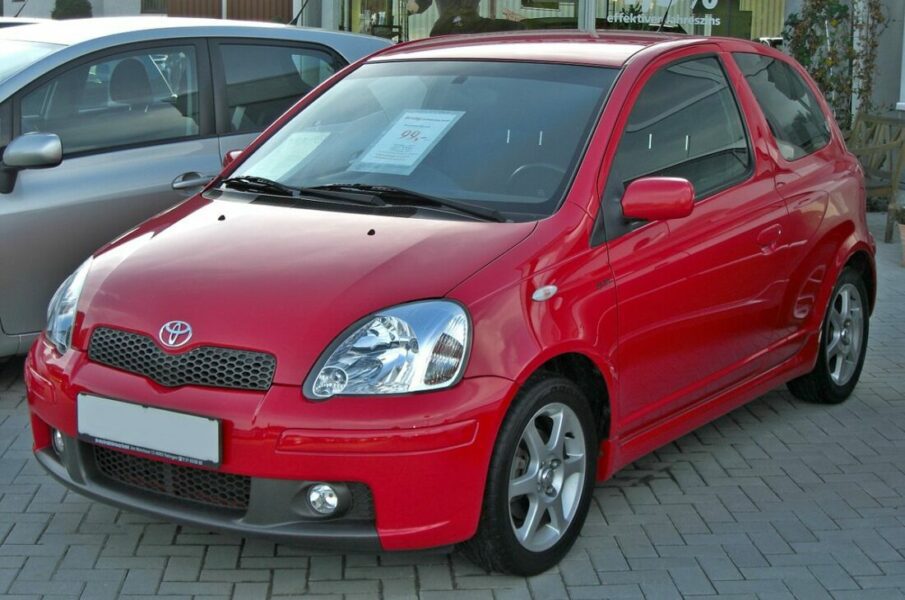
Test drive Toyota Yaris TS
Externally, the Yaris TS is so different from the more civilian versions that you can easily distinguish it from them. The front bumper with integrated fog lights is different, more aggressive, a different mask and a slightly changed shape of the headlights. 17-inch wheels are fitted as standard, with plastic sill trims optically connected to the front and rear wheels, and sportiness is also reflected in the discreet spoiler above the rear window. The taillights, which use LED technology, are completely new, the rear bumper is sportier and the exterior is rounded off by a more aggressive tailpipe trim. The Yaris TS will be available in four body colors, one of which (gray) will only be available in this Yaris version.
The interior is much less of a hint that this is the highlight of this model's offer. The seats have been replaced, but the seat is still too high, on a seat that is too short and too far from the steering wheel that moves too slowly. The sensors are different (still located in the center), now they are analog and illuminated with orange light (of course with Optitron technology). Less transparent than the classic Yaris and nothing more sporty. The steering wheel is covered in leather, the gear lever is covered too (it also has a chrome upper), and that's where the list of changes from the regular Yaris ends slowly.
Nothing shocking then, and not enough for TS to really deviate. Manual air conditioning is also standard, otherwise the Yaris TS will have two trim levels in Slovenia (where it will be available from mid-May in both three- and five-door versions). The base one will be based on the Stella hardware and the best equipment package will be based on the Yaris 'Sol hardware - both of course adding everything that separates the TS from the regular Yaris. Prices will be quite affordable, with a base TS priced around 14 euros, which is about the same as 1 liter salt. So ditch the automatic air conditioning and opt for a sportier look and an extra 3 horsepower instead. A better-equipped five-door TS will cost around 40 euros.
Subcutaneous changes are more noticeable. The chassis is eight millimeters lower, the springs and dampers (with the addition of return springs) are slightly stiffer, the front sway bar is slightly thicker, and the body is slightly reinforced around the front and rear suspension mounts. Its design remains the same as the regular Yaris, with MacPherson struts and L-rails at the front and semi-rigid at the rear.
The electric power steering is a bit less indirect, but they also changed the steering ratio and made it more responsive (only 2 turns from one extreme point to the other). Under the hood is a brand new 3-liter engine. Like the new 1-litre four-cylinder petrol engine in the Auris, the new Yaris also boasts Dual VVTi technology, i.e. variable steering for both intake and exhaust camshafts. The system works hydraulically resulting in a fairly flat (and high) torque curve. 8 "horsepower" is not something that would drive sports car enthusiasts crazy, but the Yaris TS is enough to move briskly, and due to the sufficient torque, the feeling during acceleration from low revs is also good.
Competitions mainly consist of 150-200 "horses", so the Yaris can hardly be called an athlete, which also proved itself well on the road. The gearbox is "only" a five-speed, too much lean in corners (despite precise steering), the Vehicle Stability Control (VSC) cannot be disabled. No, Yaris TS is not an athlete, but a great amateur athlete.
TS has 133 horses
engine (design): four-cylinder, in-line
Engine displacement (cm3): 1.798
maximum power (kW / hp at rpm): 1/98 at 133
maximum torque (Nm @ rpm): 1 @ 173
maximum speed (km / h): 173 at 4.400
acceleration 0-100 km / h (s): 9, 3
fuel consumption for ECE (l / 100 km): 7, 2
Dušan Lukić, photo: factory
